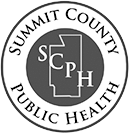Summit County Public Health conducts surveillance of tick-borne diseases and offers education to the public about how to avoid, identify and remove ticks. Keep reading for more information, or see the FAQ page to download additional resources, including photos to help you identify tick species in Ohio.
Be Tick Smart!
PROTECT against tick bites
Avoid areas where ticks live.
- Avoid wooded and brushy areas with high grass and leaf litter.
- Walk in the center of trails.
- Take extra precautions in spring, summer and fall when ticks are most active.
Use tick repellents.
- Use insect repellents registered by the U.S. Environmental Protection Agency (EPA) labeled for use against ticks on exposed skin for protection that lasts several hours. Always follow the product label. Parents should apply this product to their children, avoiding their hands, eyes, and mouth.
- Treat clothing and gear, such as boots, pants, socks, and tents with products containing 0.5 percent permethrin. It remains protective through several washings. Always follow the product label. Pre-treated clothing is available and may provide longer lasting protection.
Cover up to keep ticks off your body.
- Wear long pants, long sleeves, and long socks.
- Tuck pant legs into socks or boots and tuck shirts into pants to keep ticks on the outside of your clothing.
- Light-colored clothing will help you spot ticks more easily
CHECK for ticks
Don't let ticks hitchhike inside on your clothing.
- Remove ticks from your clothes before going indoors.
- Examine gear and pets. Ticks can ride into the home on clothing and pets, then attach to a person later, so carefully examine pets, coats, and day packs.
- Tumble dry clothes in a dryer on high heat for 10 minutes to kill ticks on dry clothing after you come indoors. If the clothes are damp, additional time may be needed. If the clothes require washing first, hot water is recommended.
Check your whole body for ticks.
- Bathe or shower as soon as possible after coming indoors (preferably within two hours) to more easily find and wash off any ticks that may be crawling on you.
- Conduct a full-body tick check using a hand-held or full-length mirror to view all parts of your body upon return from tick-infested areas. Parents should check their children for ticks under the arms, in and around the ears, inside the belly button, behind the knees, between the legs, around the waist, and especially in their hair.
REMOVE ticks as soon as you can
Use a removal method that is proven to work.
- The best way to remove a tick is to use fine-tipped tweezers to grasp the tick as close to the skin's surface as possible.
- Pull away from your skin with steady, even pressure.
- Don't twist or jerk the tick; this can cause the mouth-parts to break off and remain in the skin. If this happens, remove the mouth-parts with tweezers. If you are unable to remove the mouth-parts easily with clean tweezers, leave it alone and let the skin heal.
- Dispose of a live tick by putting it in alcohol, placing it in a sealed bag/container, wrapping it tightly in tape, or flushing it down the toilet. Never crush a tick with your fingers.
- Wash your hands and the bite area with soap and water.
- Do not use petroleum jelly, a hot match, nail polish, or any other 'folk' remedies to remove a tick. These methods do not work.
CDC has developed interactive tool that will guide you through the process of removing attached ticks and seeking healthcare, if appropriate, after a tick bite.
WATCH for symptoms
Many tickborne diseases can have similar signs and symptoms. The most common symptoms of tick-related illnesses are:
- Fever/chills: With all tick-borne diseases, patients can experience fever at varying degrees and time of onset.
- Aches and pains: Tick-borne disease symptoms include headache, fatigue, and muscle aches. With Lyme disease, you may also experience joint pain. The severity and time of onset of these symptoms can depend on the disease and the patient's personal tolerance level.
- Rash: Lyme disease, southern tick-associated rash illness (STARI), Rocky Mountain spotted fever (RMSF), ehrlichiosis, and tularemia can result in distinctive rashes.
Tick-borne diseases can result in mild symptoms treatable at home to severe infections requiring hospitalization. Although easily treated with antibiotics, these diseases can be difficult for physicians to diagnose. However, early recognition and treatment of the infection decreases the risk of serious complications. So see your healthcare provider immediately if you have been bitten by a tick and experience any of the symptoms described here.
CDC has developed interactive tool that will guide you through the process of removing attached ticks and seeking healthcare, if appropriate, after a tick bite.
page updated 06-05-2025
